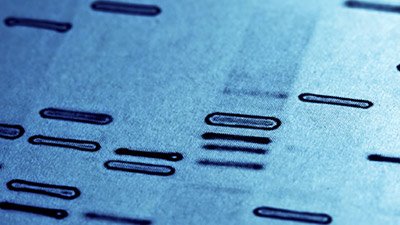
Modern East Asians and Denisovans Share Genes
Net of Denisovan cousins widens.
News Source
Denisovan people—considered “archaic humans” by most anthropologists—are known only on the basis of a finger bone and a couple of teeth from a Siberian cave. The discovery of Denisovan genes in natives of Oceania has now been joined by research published in the Proceedings of the National Academy of Sciences to compel further adjustments in the popular model for human evolution.
Although Denisovan people apparently left little in the way of an archaeological or anthropological footprint, their legacy is a fairly wide ancestral contribution.
Although Denisovan people apparently left little in the way of an archaeological or anthropological footprint, their legacy is a fairly wide ancestral contribution. Mattias Jakobsson and Pontus Skoglund of Uppsala University, analyzing genotype data from around the world, have found that Denisovan genes are not only found in Melanesian people but also in Southeast Asians.
“We found that individuals from mainly Southeast Asia have a higher proportion of Denisova-related genetic variants than people from other parts of the world, such as Europe, America, West and Central Asia, and Africa. The findings show that gene flow from archaic human groups also occurred on the Asian mainland,” says Jakobsson.
“Our study covers a larger part of the world than earlier studies, and it is clear that it is not as simple as we previously thought. Hybridization took place at several points in evolution, and the genetic traces of this can be found in several places in the world. We'll probably be uncovering more events like these.”
Because complete genomes of modern humans “are only available from some dozen individuals today,” Skoglund and Jakobsson cast a wider net by searching genotype databases. Genotype information is less complete than full sequences, but a vast amount of genotype data exists. Analysis using genotypes can overlook “unusual variants” and thus prejudice results, but genotype data provided a way to screen a large worldwide sample for Denisovan genes.
“While we can see that genetic material of archaic humans lives on to a greater extent than what was previously thought, we still know very little about the history of these groups and when their contacts with modern humans occurred,” says Skoglund. The absence of Denisovan genes in other parts of the world coupled with the wide presence in Asia and Oceania is prompting anthropologists to consider other permutations of the “Out of Africa” model. That model has already had to morph to conform to the admission of Neanderthals to ranks of people co-existing with modern humans.
Evolutionary anthropologists suggest modern humans diverged from the Neanderthal-Denisovan branch 300,000 to 500,000 years ago. And they suggest the “hybridization” of Denisovans with those moderns occurred 20,000 to 40,000 years ago. However, the latter estimate, like the initial divergence, “is based on models of the rates that genes typically mutate and could be off the mark.”1
As the “Out of Africa” model for humans evolving in Africa gets adjusted to allow multiple migrations of co-existing interbreeding people groups, we need to realize that the model is based on the notion that humans share a common ancestor with apes.
As the “Out of Africa” model for humans evolving in Africa gets adjusted to allow multiple migrations of co-existing interbreeding people groups, we need to realize that the model is based on the notion that humans share a common ancestor with apes. Museums abound with assertions that the fossil record proves this connection. In reality, the only ape-men are ape fossils mislabeled as human-related and human fossils misidentified as apes.
Jakobsson says, “It is not as simple as we previously thought. Hybridization took place at several points in evolution, and the genetic traces of this can be found in several places in the world.” In fact, the story is actually quite simple. The Bible tells it.
Emerging genetic data on Neanderthals and now Denisovans is increasingly demonstrating that humans are all of one race. “Hybridization” is a terrible term for this genetic mixing since all people groups—whether classified “archaic” and modern—descended from Adam. All those descended from Noah’s family—the only people to survive the Flood—supplied the gene pool we see today, unmixed with ape or any sort of transitional subhuman. Noah’s descendants dispersed from the tower of Babel. As people groups became isolated, limitations in genetic variability combined with other genetic phenomena such as founder effects produced the people groups in anthropological catalogues, including Neanderthals and Denisovans. The fact that their genetic presence can now be tracked across the world’s geography testifies to the fact they and all other people are related, some more closely than others, with dispersal patterns now being found not representing evolutionary emergence from Africa but dispersal from the plains of Shinar.
Further Reading
- Those Enigmatic Neanderthals
- Recovery of Neandertal mtDNA: An Evaluation
- Modern Humans with Neanderthal History
- The Trouble with Sequencing
- Are Europeans Neandertal?
For More Information: Get Answers
Remember, if you see a news story that might merit some attention, let us know about it! (Note: if the story originates from the Associated Press, FOX News, MSNBC, the New York Times, or another major national media outlet, we will most likely have already heard about it.) And thanks to all of our readers who have submitted great news tips to us. If you didn’t catch all the latest News to Know, why not take a look to see what you’ve missed?
(Please note that links will take you directly to the source. Answers in Genesis is not responsible for content on the websites to which we refer. For more information, please see our Privacy Policy.)
Footnotes
- Brian Switek, “Fossil Finger DNA Points to New Type of Human,” Wired, December 22, 2010, http://www.wired.com/wiredscience/2010/12/denisovans/.

Answers in Genesis is an apologetics ministry, dedicated to helping Christians defend their faith and proclaim the good news of Jesus Christ.
- Customer Service 800.778.3390
- Available Monday–Friday | 9 AM–5 PM ET
- © 2025 Answers in Genesis


